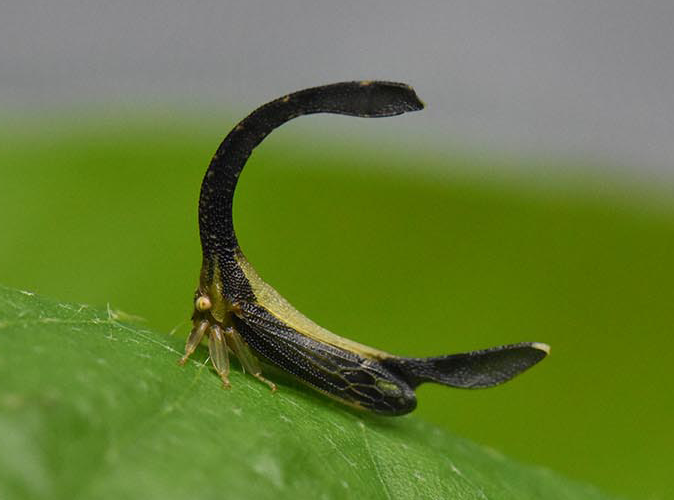🐞 Cladonota: the alien-looking insect with bizarre horns
In a world where nature paints flowers and leaves, the Cladonota chose sculpture. On its back it doesn’t carry bright colors, but bizarre horns and baroque shapes that look as if they were carved by an invisible artisan. Seen up close, it almost resembles a tiny H.R. Giger project: an insect that blurs the line between biology and science fiction, a living artwork walking through the branches of tropical forests.
🌿 A living sculpture on its back
The Cladonota belongs to the family of membracids, insects famous for their incredible dorsal “ornamentations.” In its case, the body sprouts spines, horns, and protrusions that look like a medieval armor or even alien antennas. These structures are not just decorative: they help confuse predators, making the insect harder to identify.
👀 Extreme camouflage
Many Cladonota species show colors that imitate twigs, thorns, or bits of bark. If you don’t know where to look, you may mistake it for a fragment of wood. It’s the perfect strategy: invisibility through the strangest design evolution could come up with.
🧬 Internal biology: tiny but complex
Despite its alien look, the Cladonota shares the same internal anatomy as most insects. Its body is divided into head, thorax, and abdomen.
- It has a piercing-sucking mouthpart used to feed on plant sap.
- Its circulatory system is open, with hemolymph flowing freely around its organs.
- The nervous system is a chain of ganglia, coordinating the fast movement of legs and control of the wings.
- Respiration takes place through tracheae and spiracles, tiny openings that deliver oxygen to its tissues.
Behind those science-fiction-like horns hides a miniature but finely engineered organism.
🔄 Evolutionary oddities
The spectacular protrusions of Cladonota are an example of how evolution can experiment with extreme shapes. They don’t serve any vital role (they are not for breathing or eating), but they act as a passive defense: they trick predators, mimic twigs or thorns, and increase survival chances.
It’s a case of creative natural selection, where the strangest-looking survive, not the strongest.
🎭 Art, biology or science fiction?
Looking at a Cladonota up close feels like observing a miniature steampunk creation: crossing horns, spines resembling radio antennas, shapes that look like a warrior’s helmet. Unsurprisingly, these insects are often photographed and admired by entomologists and lovers of natural oddities.
🌍 Where it lives
The Cladonota lives mainly in the tropical regions of the Americas, especially in rainforests, where camouflage is essential to survive among predators and dense vegetation. They are small — just a few millimeters up to a couple of centimeters — but if you spot one, you won’t forget it.
✨ Nature never stops surprising us
The Cladonota is living proof that nature is the greatest artist. Every time we think we’ve seen it all, a new insect appears with the most incredible “horns” imaginable. Who needs science fiction when reality is already this creative?
Conclusion
The Cladonota is more than a small tropical insect: it is a biological jewel reminding us how evolution can be both creative and functional. Next time you think of insects as simple nuisances, remember that somewhere in a distant forest, a tiny alien-like warrior is walking undisturbed along the branches.








Leave a Comment